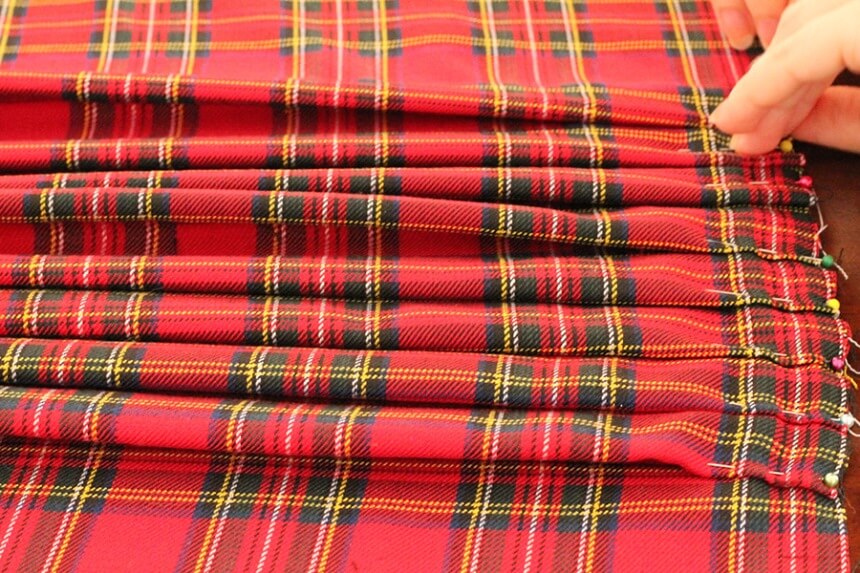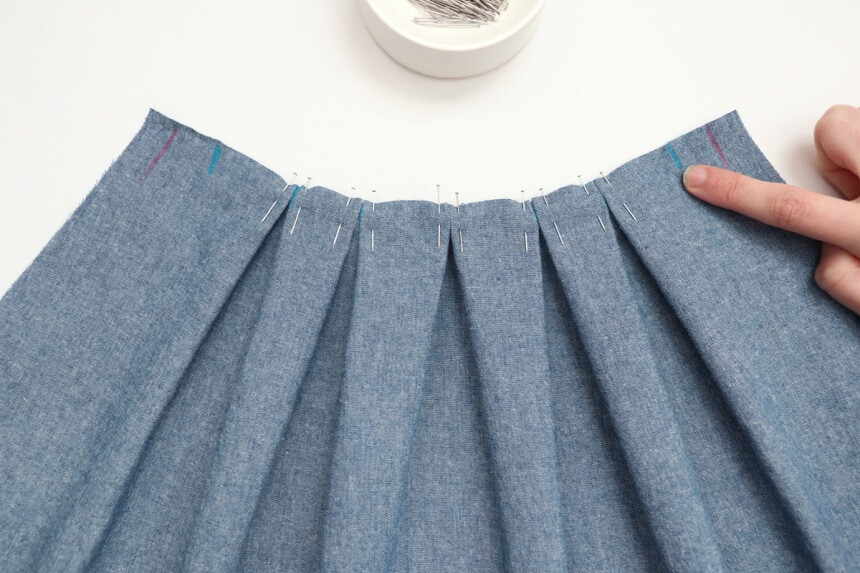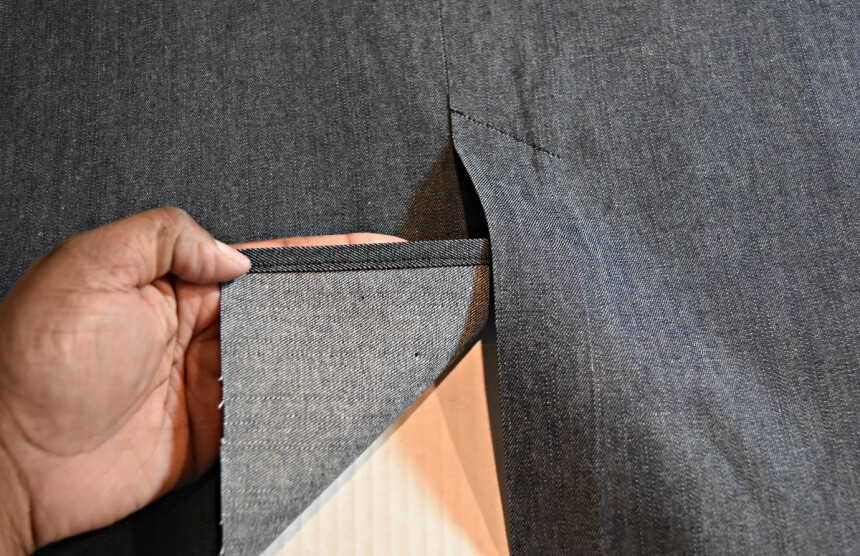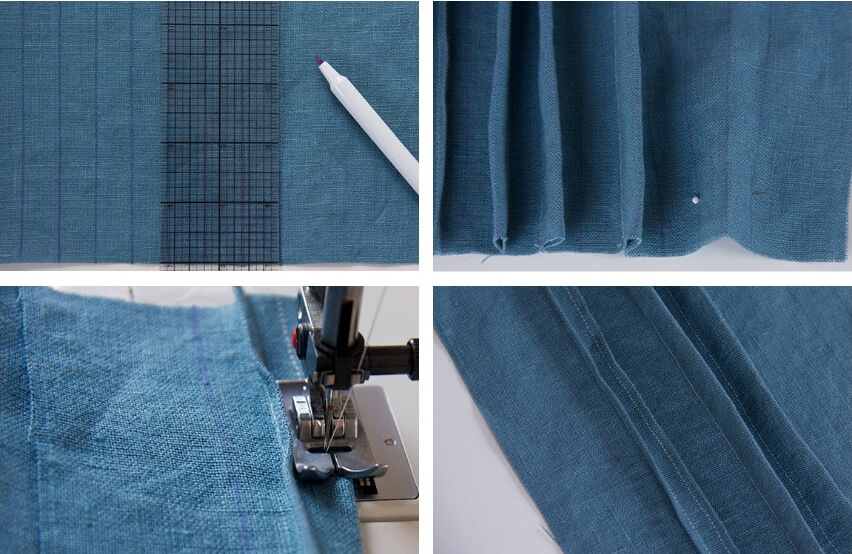

Pleats are the way to arrange fabrics to add volume to it, held in place using a sewing pin before getting stitched into the fabric. To most people, all pleats are the same. Meanwhile, if you take a closer look, you will discover that they come in different shapes and forms.
There are pleats best suited for décor items such as curtains, while others appear better on fashion items such as skirts, gowns, and coats. In this guide, we will be outlining the various available as well as the clothing they are perfect for.
You need to determine the effect you want to create in a piece of fabric before deciding on which type of pleats to use. Some pleats add volume to clothes while others alter the shape of fabric for added comfort. In the case of skirts, the option is numerous no matter the type of skirt or dress sewn.
We’ve outlined the different types of pleats commonly used below and the type of fabrics they’re used on.
 Box pleats are not the most common type of pleats you will find on fabrics. They can come in single or double layers. Usually, they contain dual creases facing a different direction to form a raised section at the middle of both creases.
Box pleats are not the most common type of pleats you will find on fabrics. They can come in single or double layers. Usually, they contain dual creases facing a different direction to form a raised section at the middle of both creases.
This type of pleats is hardly found in clothing outfits. Rather, they’re used on home décor items such as curtains, and table skirting.
Note: Before you start, you may want to determine the size and spacing of the pleats based on the specific project you’re working on.
 Knife Pleats
Trusted Source
Knife Pleat | Fashion A-Z | BoF Education | The Business of Fashion
From applique to zippers, a comprehensive dictionary with definitions and meanings of key fashion vocabulary, written by Camilla Morton.
www.businessoffashion.com
are handmade pleats pressed firmly to face one direction. These types of pleats are usually found in skirts and are made to lie flat. For knife pleats to look stunning on any fabric, they have to be pressed with a hot iron to remove wrinkles. One of the best pressing irons for making pleats is the 360 Degrees Cordless Steam and Dry Iron from Panasonic. Ideal for freestyling, this gives fabrics a smooth and silky appearance.
Knife Pleats
Trusted Source
Knife Pleat | Fashion A-Z | BoF Education | The Business of Fashion
From applique to zippers, a comprehensive dictionary with definitions and meanings of key fashion vocabulary, written by Camilla Morton.
www.businessoffashion.com
are handmade pleats pressed firmly to face one direction. These types of pleats are usually found in skirts and are made to lie flat. For knife pleats to look stunning on any fabric, they have to be pressed with a hot iron to remove wrinkles. One of the best pressing irons for making pleats is the 360 Degrees Cordless Steam and Dry Iron from Panasonic. Ideal for freestyling, this gives fabrics a smooth and silky appearance.
Knife pleats usually give fabrics a slim look. They create an effect that ensures the fabric doesn’t stay glued to the wearer’s body. This makes the fabric comfortable and flexible when worn.
 Inverted pleats are similar to knife pleats. They are double knife pleats facing opposite directions. It’s formed by stitching large folds of fabric together in the middle. An inverted pleat is also what you get when you turn a box pleat inside out
Inverted pleats are similar to knife pleats. They are double knife pleats facing opposite directions. It’s formed by stitching large folds of fabric together in the middle. An inverted pleat is also what you get when you turn a box pleat inside out
Unlike most pleats that run down, inverted pleats are only held at the top with headpins before they are stitched together.
Made by Singer, a popular sewing equipment manufacturer, the best straight pin kit is the SINGER 07051. It is recognized by seamstresses and ranked # 1 as Amazon’s best singer straight pins. By using these, the pleating becomes less visible as you move towards the bottom of the dress.
This type of pleats doesn’t look good on full-length gowns. Rather, they’re formed on mini gowns especially those that are at knee or thigh length.
 Kick pleats are usually small pleats appended to the bottom of the fabric to give the wearer more freedom of movement. They are mostly attached to the back of a skirt or coat. In the case of a tight skirt, it’s done to allow the wearer to walk freely. Hence, kick pleats are the right fit for skirts that run beyond the knee if the wearer wants to extend his leg over some inches.
Kick pleats are usually small pleats appended to the bottom of the fabric to give the wearer more freedom of movement. They are mostly attached to the back of a skirt or coat. In the case of a tight skirt, it’s done to allow the wearer to walk freely. Hence, kick pleats are the right fit for skirts that run beyond the knee if the wearer wants to extend his leg over some inches.
 Unlike handmade Knife pleats, accordion pleats are sewn with a machine. This ensures they’re permanently affixed to the fabric, hence, their shape can’t be altered by a simple sewing iron or after washing.
Unlike handmade Knife pleats, accordion pleats are sewn with a machine. This ensures they’re permanently affixed to the fabric, hence, their shape can’t be altered by a simple sewing iron or after washing.
The shape of an accordion pleat is zigzag, but it widens out as you approach the bottom to form a burst. This makes them slim at the top but full at the bottom. Making them a perfect fit for all body types.
 Pintuck pleats are a type of decorative fold used in clothing and textiles. They are created by stitching multiple parallel lines of tucks, or gathers, into the fabric, creating small, uniform pleats.
Pintuck pleats are a type of decorative fold used in clothing and textiles. They are created by stitching multiple parallel lines of tucks, or gathers, into the fabric, creating small, uniform pleats.
Pintuck pleats are commonly used in clothing such as blouses, dresses, and skirts, and are often added to the front, back, or sleeves of a garment to add texture and visual interest. They can be created in a variety of sizes and styles, ranging from tiny, delicate pleats to large, bold gathers. The type and size of the pintuck pleat can affect the overall look and feel of the garment, making them a versatile embellishment for designers to work with.
Fabrics with a tighter weave, such as cotton, silk, and linen, tend to hold pleats the best. These fabrics have a firmer structure, which helps to keep the pleats in place and maintain their shape.
Wool is also a good choice for pleats as it has a natural springiness that helps to maintain the shape of the pleats. Synthetic fabrics, such as polyester, can be used for pleats, but they may not hold the pleats as well as natural fibers.
Pleat depth Trusted Source How to Sew Pleats You might think you know everything about pleats, but watch this video just in case. www.seamwork.com refers to the distance between the folded edge of a pleat and the base of the fabric. It determines the height of the pleat and affects the overall appearance of the finished product. A deeper pleat will result in a more pronounced, dramatic look, while a shallower pleat will create a more subtle, understated look.